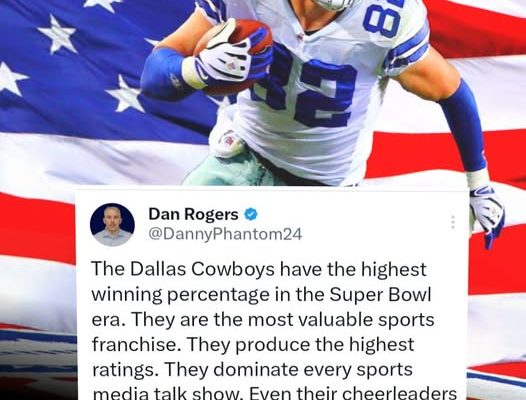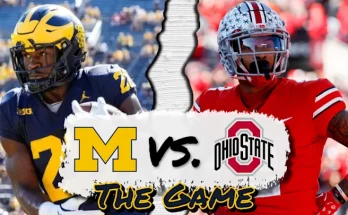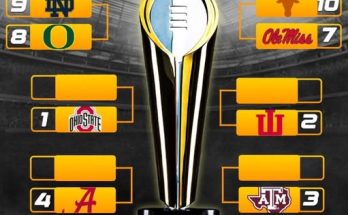In the annals of NFL history, few franchises command the combination of legacy, success, and cultural magnetism like the Dallas Cowboys. Known worldwide as “America’s Team,” the Cowboys have not only built a global brand but also achieved a feat that stands as a benchmark for sustained excellence—they hold the highest winning percentage in the Super Bowl era. This achievement is not simply a result of a few successful seasons or the fleeting brilliance of a generational quarterback; instead, it is the product of decades of high standards, strategic management, exceptional coaching, and an unwavering expectation of greatness. From the earliest days of the Super Bowl era in 1966 to the present day, the Dallas Cowboys have remained a towering presence in the NFL, crafting a narrative that’s deeply entwined with the league’s evolution and public consciousness.
This statistical dominance is more than a footnote; it is a compelling indicator of consistency and competitiveness across generations of players and front-office leadership. While many franchises have experienced peaks and valleys, often falling into years of irrelevance between fleeting successes, the Cowboys have more often than not remained within striking distance of contention. Through shifting trends, player turnover, and coaching changes, they have exhibited an ability to adapt and evolve without sacrificing their core identity—winning.
The Super Bowl era, beginning in 1966, ushered in a new era of professional football, marked by the championship game that would become one of the most-watched sporting events in the world. From that point forward, the metric of excellence changed. It was no longer about who had the most titles pre-merger or who was dominant in a smaller, less competitive league. Instead, it was about who could consistently perform at the highest level in a rapidly growing, ultra-competitive environment. In that context, the Dallas Cowboys separated themselves from the rest.
Their climb to the top of the win-percentage mountain began in earnest under the leadership of legendary head coach Tom Landry and general manager Tex Schramm. The Cowboys were a young franchise in the 1960s, but under Landry’s stoic leadership and revolutionary defensive schemes, they began establishing a culture of preparation and excellence. Dallas became known for its rigorous scouting system and methodical approach to player development, producing stars like Roger Staubach, Bob Lilly, and Mel Renfro. The result was not just playoff appearances but dominance. Between 1966 and 1985, the Cowboys missed the playoffs only twice. That’s a 20-year stretch in which they were the gold standard for consistency.
Even as coaching regimes changed—from Landry to Jimmy Johnson, Barry Switzer, Bill Parcells, and others—the franchise continued to produce winning football. In the 1990s, a decade marked by salary cap challenges and parity, the Cowboys once again rose to the top, this time behind a trio that came to define the era: quarterback Troy Aikman, running back Emmitt Smith, and wide receiver Michael Irvin. Under Johnson and Switzer, Dallas won three Super Bowls in four years, once again asserting their status as a dynasty. By the end of that run, the Cowboys had firmly established themselves as the league’s winningest franchise of the modern era.
But this high winning percentage is not just about rings. It’s about week-to-week excellence. Every NFL season consists of a grueling 17-game schedule in which every win counts toward that ultimate statistical measure. While Super Bowls garner the headlines and define legacies, the winning percentage across decades illustrates a broader and perhaps more important reality: that Dallas is almost always in the conversation. That they are almost always competitive. And that they almost never descend into the prolonged futility that plagues so many other franchises.
Consider the sheer difficulty of maintaining a high win percentage across such a volatile league. Free agency, injuries, coaching turnover, and the draft all inject a level of unpredictability that makes sustained success extremely rare. For every Patriots dynasty or Steelers resurgence, there are dozens of teams that flash briefly before fading into obscurity. Yet, the Cowboys have avoided such fates more often than not. Even in their less successful periods—the post-Aikman years or the mid-2010s—Dallas has often remained in playoff contention. And when they fall out of it, they typically don’t stay down for long.
One of the most interesting aspects of the Cowboys’ winning tradition is how it has persisted across eras that demand different styles of football. In the 1970s and 80s, their identity was forged in discipline, defense, and a run-first offensive scheme. In the 90s, it was the power running game and precision passing. In the 2000s and 2010s, the team adjusted to the spread offenses and hybrid defenses that became the league norm. Throughout all this, they have developed elite talent at nearly every position group—from quarterbacks like Staubach, Aikman, Tony Romo, and Dak Prescott, to dominant linemen like Larry Allen and Tyron Smith, to game-changing defenders like DeMarcus Ware and Micah Parsons.
The front office, particularly under the stewardship of Jerry Jones since 1989, has remained ambitious, aggressive, and dedicated to winning, even if not always with unanimous public support. Jones’ ownership has been marked by headline-grabbing moves, some controversial coaching hires, and a deep investment in turning the Cowboys into not just a team, but a brand. While critics have pointed to a lack of recent Super Bowl appearances as a blemish on that legacy, the consistent win totals year in and year out tell a more nuanced story. Success in today’s NFL is as much about staying competitive in the long term as it is about rings.
Another reason the Cowboys’ winning percentage stands out is because they play in one of the toughest divisions in football—the NFC East. The division boasts multiple Super Bowl-winning franchises including the New York Giants, Philadelphia Eagles, and Washington Commanders (formerly Redskins), all of whom have enjoyed stretches of dominance. Division games are notoriously unpredictable and intense, meaning that stacking up wins isn’t easy. Yet Dallas has often emerged from this gauntlet with enough victories to maintain its status atop the win-percentage leaderboard.
Their home stadium has also been a fortress. Whether it was the iconic Texas Stadium or the state-of-the-art AT&T Stadium—often dubbed “Jerry World”—the Cowboys have enjoyed one of the most intimidating home-field advantages in football. The venue itself is a testament to the franchise’s commitment to excellence, not just on the field but off it. With one of the highest attendance rates in the NFL, Dallas continues to lead the league in gate revenue and merchandise sales, driven in part by their consistent on-field success.
Additionally, their influence stretches beyond the gridiron. The Cowboys have played on more Thanksgiving games, Sunday Night Football matchups, and nationally televised broadcasts than any other team. Networks schedule them prominently because fans tune in to watch the Cowboys. And fans tune in because the Cowboys usually win. That virtuous cycle—of popularity and performance—reinforces the franchise’s place at the top of the NFL’s hierarchy.
Critics may argue that recent playoff shortcomings weaken the Cowboys’ claim to greatness, especially when compared to the championship success of teams like the Patriots under Tom Brady or the 49ers in their 1980s heyday. But the metric of winning percentage across the Super Bowl era tells a broader, more reliable story of football excellence. A story not of brief dynasties, but of staying power. Not of once-a-decade success, but of year-after-year competitiveness.
It’s easy to remember teams for their Super Bowl wins, but harder to appreciate the grind of remaining relevant across multiple generations. The Cowboys have not simply participated in that grind—they’ve dominated it. The winning percentage is evidence not just of what they’ve accomplished but of what they represent: an expectation of victory, a tradition of toughness, and a belief that greatness is not an occasional outcome but a continuous standard.



